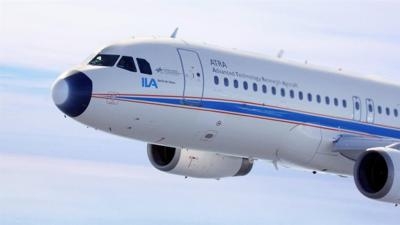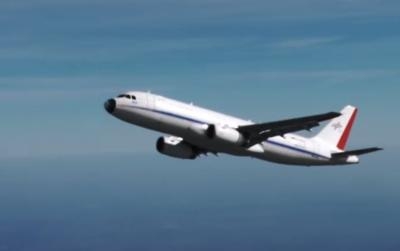Goal Is For Slower And Quieter Approaches, Fuel Savings
Germany's DLR Advanced Technology Research Aircraft (ATRA) flew at the limits of its capabilities between March 16 and 19, 2015. In a total of four flights, the test pilots flew the specially instrumented A320 passenger jet at extremely low speeds. The goal was to explore details of the airflow over the wings and flap systems. The German Aerospace Center (Deutsches Zentrum für Luft- und Raumfahrt; DLR) is working with Airbus to investigate low-speed flight characteristics of commercial aircraft. The results are targeted to allow lighter future wing designs and optimise them for slower – and thus quieter – approaches.

Each time, DLR test pilot Hans-Jürgen Berns and Airbus test pilot Eckhard Hausser took off from the research airport at Braunschweig and headed for a specially reserved airspace. During each of the test flights, the pilots conducted around 30 stall maneuvers with ATRA. "We slowly pull the nose of the ATRA up at reduced thrust, so that we achieve maximum lift," says DLR test pilot Berns, explaining the manoeuvre. "Exceeding maximum lift causes a significant loss of altitude while the aircraft nose drops again before we recover the aircraft." The particular challenge for the cockpit crew was to carry out the manoeuvre as controlled as possible to minimise any lateral movements. "As a result of numerous certification flights, we at Airbus are very familiar with this manoeuvre," says Hausser. "Thus, we could perform the ATRA stall without major difficulties."
To pave the way for the researchers to follow detailed computer simulations of the flow features on the wings, a sophisticated package of dedicated measurement technology was installed on both wings during several weeks of preparations. TU Berlin distributed some 25 fist-sized, flat so called 'hot films' to measure friction effects on the wing surface; in addition, nine associated calibration probes and four boundary layer rakes were installed for flow velocity measurements. TU Braunschweig contributed with four in-house developed devices for measuring the unsteady flow field over the wing, which were referred to as 'boundary layer mice' because of their shape. The air flowing immediately above the wing is called the boundary layer, and its behaviour is decisive for optimum low speed airflow. DLR set up the basic instrumentation and its pressure measurement system.
Under the High Lift Inflight Validation (HINVA) joint project, the researchers are investigating with unmatched accuracy and detail how the flow behaves on the wing and flaps during low-speed flight, particularly in the areas near the engine nacelles. Project leader Ralf Rudnik from the DLR Institute of Aerodynamics and Flow Technology is confident: "We strive to better understand the aerodynamic limits during low flight speed conditions, to take full advantage of this knowledge for future high lift designs."
The longer-term objective is to enable commercial aircraft to fly slower during their final approach, which makes them quieter and allows the use of shorter runways. Today, manufacturer specifications set the approach flight speed of passenger aircraft to between 200 and 250 kilometres per hour. The precise values depend on the type of aircraft and the landing weight. "Together with the results of previous complementary flight tests and wind tunnel measurements, the flight test data now acquired will contribute to the improvement of computer-aided flow simulations. At DLR, we run these simulations on high performance computers of the Center for Computer Applications in Aerospace Science and Engineering (C²A²S²E), which is the largest computing center dedicated to aircraft research in Europe," says Rudnik. "This will enable the development of wings and flap systems that are further adapted to low-speed flight, saving weight and fuel and reducing the speeds and noise emissions around
airports in the long term."

Because the targeted accurate prediction of flow processes during take-off and landing will make an important contribution to the improvement of future aircraft development, joint partner Airbus is very actively supporting the HINVA project as part of its research activities. Hence, through its support of the integration of the flight test instrumentation and the provision of Airbus staff for the mixed crew, Airbus is significantly contributing to the success of the tests. The basis for the successful execution of the flight tests with the aircraft fitted with sophisticated measurement technology was the collaborative partnership of the participating organizations – DLR, Airbus, TU Berlin and TU Braunschweig. The first ATRA flight tests for the HINVA project were conducted at Airbus in Toulouse in 2012. Unlike the initial test flights in 2012, DLR took the overall responsibility for approval and implementation of the present flight test campaign. The HINVA project is funded as part of the German
Federal Ministry for Economic Affairs and Energy (Bundesministerium für Wirtschaft und Energie) aviation research program.
(Images provided by DLR)
 ANN's Daily Aero-Term (04.20.24): Light Gun
ANN's Daily Aero-Term (04.20.24): Light Gun Aero-News: Quote of the Day (04.20.24)
Aero-News: Quote of the Day (04.20.24) ANN's Daily Aero-Linx (04.21.24)
ANN's Daily Aero-Linx (04.21.24) Aero-News: Quote of the Day (04.21.24)
Aero-News: Quote of the Day (04.21.24) ANN's Daily Aero-Term (04.21.24): Aircraft Conflict
ANN's Daily Aero-Term (04.21.24): Aircraft Conflict




